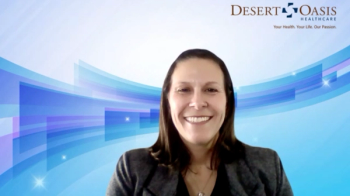
Genetics and Diabetes: Who Is Predisposed?
Peter Salgo, MD: The object, of course, would be to at least keep patients from manifesting these things, right? So if we’re going to talk about profiling people, whom do you start to look at? If you’re going to spend money looking for this and to prevent it going forward, who are the prime candidates?
Helena W. Rodbard, MD: There are lots of people [who] unfortunately are candidates [for] developing diabetes. People [who] have a family history of diabetes, [in] certain populations—African Americans, Latinos, Asian Americans, Native Americans, Pacific Islanders—these people are at much higher risk for developing diabetes; it’s genetic. But there are also certain conditions like gestational diabetes in women that will predispose women to developing later diabetes.
Peter Salgo, MD: I’ve heard this. If a woman has gestational diabetes, let’s say in her 30s, [is] she more likely to go on and become a type 2 diabetic later in life?
Helena W. Rodbard, MD: For sure. She has a much enhanced chance unfortunately of developing type 2 diabetes, and also women [who] have polycystic ovary syndrome are very good candidates for developing type 2 diabetes.
Peter Salgo, MD: You’ll forgive me, but we’re adding to this bucket. At the end of the day, pretty much everybody is in this bucket. Does it make any difference? Are there people you would not screen?
Om P. Ganda, MD: Well, I think that’s a very good question, and this has been debated. Diabetes is a progressive disease, and the earlier we diagnose it, the better. We know that certain ethnic populations are more at risk, as Helena said. People who have a family history, and people who have real progressive weight gain. These are some of the major risk factors that should really, you know, make us think about diabetes and screen people for diabetes.
Peter Salgo, MD: OK, let me get 1 more definition on the table, because I hear this all the time from [patients]. If you say, “Do you have a history of diabetes?” “No, doc, but I have a history of prediabetes.” Is that a real thing?
Helena W. Rodbard, MD: Well, we hear quite often being totally oblivious to the fact that they may actually have diabetes. They call it a touch of sugar; they have all kinds of euphemisms that we hear. But some people truly have prediabetes, and it’s very important to diagnose prediabetes.
Peter Salgo, MD: But what is it? I keep hearing this. What is prediabetes?
Helena W. Rodbard, MD: Yeah, there [are] several definitions for prediabetes.
Peter Salgo, MD: I knew this was coming.
Helena W. Rodbard, MD: The American Diabetes Association [makes] it very easy nowadays. All we need to do is to get a blood sample, a hemoglobin A1C [glycated hemoglobin], and if the level is between 5.7% and 6.4%.
Peter Salgo, MD: The A1C.
Helena W. Rodbard, MD: Hemoglobin A1C level, right. This person is labeled as having prediabetes. There are other criteria as well. A fasting plasma glucose between 100 and 125 mg/dL; above 126, it is over diabetes. Less than that, it can be prediabetes.
Peter Salgo, MD: You’ll forgive me. If I found somebody [and] I was checking a fasting blood sugar of 120 [mg/dL], I’d say, “You are a diabetic. Let’s get busy.” Is it psychologically less intrusive to say you’re a prediabetic?
Helena W. Rodbard, MD: No, it’s not. Actually, it should be an alert. It should be a red flag for the person [who] has prediabetes. And that is an optimal time for us to intervene and try to prevent the person from going down that slippery slope, going from prediabetes to overt diabetes, with all the complications that we just heard from Om.
Peter Salgo, MD: Let me ask this question, because implied in your answer is that if we intervene, we can make a difference. Is it possible to take somebody with prediabetes and, by intervening, prevent them from becoming diabetic? Or is it inevitable?
Om P. Ganda, MD: We have a lot of evidence for that. We have a number of long-term diabetes prevention trials that have been carried out, including 1 in our own country called the DPP [Diabetes Prevention] Program. And we took people like this who had prediabetes, [of] various ethnic backgrounds, and put them on a diet-and-exercise program or a pill, and we were able to show in the course of 3 years that we can prevent the progression from prediabetes to diabetes by 58%—call it 60%.
Peter Salgo, MD: First of all, that’s a huge number.
Om P. Ganda, MD: That’s a huge number.
Peter Salgo, MD: We’re used to seeing 3%, 4%, [so] that’s significant. That’s a big number.
Om P. Ganda, MD: It was really an eye-opener.
Peter Salgo, MD: It really is. And the important safety tip [is to] get on this thing.
Helena W. Rodbard, MD: Amazing, absolutely amazing. And actually, this is the group, as Om said, that had intensive lifestyle modifications. And what they meant by intensive lifestyle modification [is] basically exercising 30 minutes 5 times a week. [That’s] not something that’s unsurmountable; most of us can do that. And losing 7% of the body weight.
Peter Salgo, MD: OK, we’re going to get on both of those because they may not be insurmountable, they may not be Mount Everest, but they might be Mount McKinley for some people.
Helena W. Rodbard, MD: Getting there.
Peter Salgo, MD: One last question about this. If anybody is symptomatic, and by symptomatic we mean polyuria, polydipsia, [or] any of the symptoms of diabetes. Is that prediabetes ever, or is that just overt diabetes?
Helena W. Rodbard, MD: Well, the cat is out of the bag at that point. The person has diabetes. If they have symptoms, they have diabetes. Our challenge is to detect [them in] people before they develop symptoms and [to] try to prevent them.
Om P. Ganda, MD: And in most cases, fasting blood glucose [levels] will be way over 126 [mg/dL], OK? And the hemoglobin A1C will be clearly about 6.5%, but likely more than 7%.
Peter Salgo, MD: The number of people I see with, being followed with, 7% and 7.5% is depressing, actually.
Newsletter
Stay ahead of policy, cost, and value—subscribe to AJMC for expert insights at the intersection of clinical care and health economics.







































